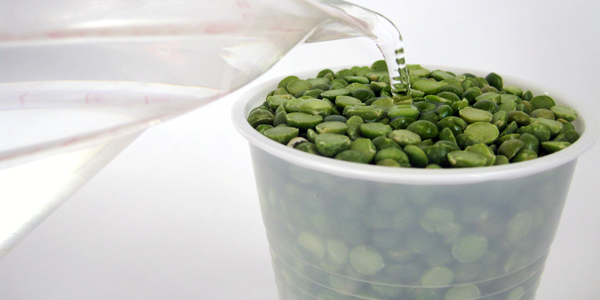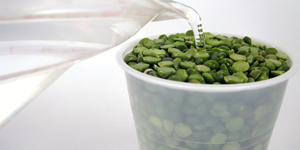Holey Porous Rock Science!
Examining rocks can be a springboard for a fun family science exploration. With different kinds of dried beans, plastic cups, and water, kids can model rocks and observe the way different sized particles in rocks affect how much water a rock can hold.

What do rocks and sponges have in common? Rocks may be hard, and sponges may be soft, but both have pockets of empty space. Surprised? It may be easier to see the pockets in sponges since most sponges are covered with holes, but if you toss a pumice stone in water, it will float—because it has many pockets of empty space, just like a sponge!
Some rocks are more like a sponge than others though. It depends on their porosity.
Porosity is the word we use to talk about the volume of empty space in an object compared to the total volume of the object. When the particles of a rock are small, they may be packed together closely with very little space between them. Such a rock is defined as not very porous. When the particles of a rock are large, there may be more space between them because they don't fit together as tightly. This makes the rock more porous.
Science Activities Mean Fun for the Whole Family
Porosity is a concept that may be hard to imagine, but with the quick and easy How Particles Affect Porosity science activity, students can make a model of a rock to observe firsthand what porosity means and how it works.
That's what Sherry Smith, a Science Buddies mom, decided to do when she was looking for a fun science activity that would appeal to both her 10-year-old daughter and 4-year-old nephew.
"Both of the kids are interested in rocks, and the techniques of Science Buddies' porosity activity seemed fairly simple," said Sherry, "so I thought it would work with my young nephew."
To build their model, the kids filled one plastic container with large dried beans and another plastic container with small dried beans. In the project, the different-sized beans represent different sizes of rock particles. Each container becomes a model for a "rock." The next step for Sherry and her students was to carefully measure how much water they could pour into each container. Which model rock holds more water? Why?
On their first try, some of the water spilled, says Sherry, so they had to start over, but in the end, their experiment was a success. The kids were able to see how the difference in the porosity of each model rock made a difference in how much water each cup held.
Learning on Different Levels
Overall, Sherry thinks that the porosity project is a great way for kids of different ages to share a memorable science experience. "While my nephew perhaps had trouble understanding that the beans were modeling porosity, he enjoyed acting like a 'real scientist' and was very careful pouring the water on the second try."
Sherry's daughter, on the other hand, was able to connect the concept of porosity to what she had learned about the rock cycle in school, particularly that the porosity of a rock can change over time due to pressure.
Modeling Rocks in the Classroom
Like Sherry and her family, students and families can experiment with porosity using the procedure in the How Particles Affect Porosity classroom science activity. Teachers looking to replicate this hands-on geology experiment in the classroom will find step-by-step guidance, including downloadable educator and student guides. The activity only takes about twenty minutes, including teacher prep time, and lets students explore how and why some rocks really soak up liquid while others do not.
Check out Science Buddies' new Science Activities for All Ages area to discover more fun science experiments and activities for the whole family! Teachers can also browse additional classroom activities.
A Deeper Look at Porosity
Students looking for a geology science fair project related to rocks can continue the exploration with the Porosity and Particle Size project idea.
Support for Geology resources and Project Ideas at Science Buddies is provided by Chevron.
Categories:
You Might Also Enjoy These Related Posts:
- 15 STEM Gifts & Science Kits You'll Feel Good About Giving
- 13 Boat Science and Submarine Science Projects and Experiments
- July 4th STEM! Summer Science Picks for Independence Day!
- 12 Science Kits for Summer Science Experiments and Discovery
- 15 Science Projects to Make and Give for Father's Day
- Ready, Set, Go! (Awesome Summer Science Experiments)
- Awesome Summer Science Experiments
- 10 STEM Activities with Cardboard Tubes










